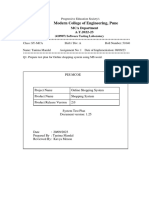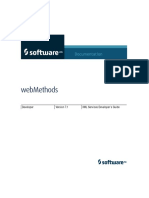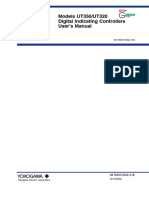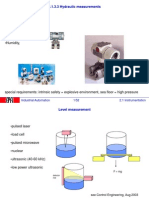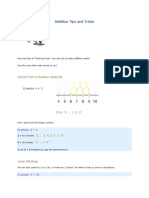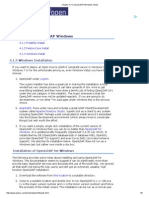Ccs366 Software Lab Manual
Uploaded by
hplamd5000Ccs366 Software Lab Manual
Uploaded by
hplamd5000lOMoARcPSD|52708450
CCS366 Software - Lab Manual
Software testing and automation (Anna University)
Scan to open on Studocu
Studocu is not sponsored or endorsed by any college or university
Downloaded by Sridhar Dharanidharan (sridhardharanidharan444@gmail.com)
lOMoARcPSD|52708450
Student Name : ................................................................................
Reg. No. : ................................................................................
Semester & Branch : ................................................................................
Class : ................................................................................
Course Code & Name : ................................................................................
Downloaded by Sridhar Dharanidharan (sridhardharanidharan444@gmail.com)
lOMoARcPSD|52708450
INSTITUTION
VISION
To be an institution of excellence committed to
quality engineering education and research
towards producing socially responsible
citizens.
MISSION
To impart quality technical education in producing competent
engineers by providing a conducive learning environment.
To build a high quality human resource capacity with focus on
professionalism and dedication.
To inculcate ethical values by adopting holistic teaching
methodologies.
To instill innovative thinking and entrepreneurial traits by
collaborating with industry and academia.
Downloaded by Sridhar Dharanidharan (sridhardharanidharan444@gmail.com)
lOMoARcPSD|52708450
DEPARTMENT OF INFORMATION TECHNOLOGY
VISION
To produce competent IT professionals with ethical values to cater to the needs of
the changing trends in the IT sector.
MISSION
M1 To impart the principles of computing to solve complex engineering problems
by exposing students in modern IT tools.
To motivate the students to contribute to society by actively involving in
M2 social welfare schemes.
To empower the students to cater to the needs of IT industry by signing the
M3 memorandum of understanding.
To inculcate the sense of professional responsibilities in computing practice
M4 based on legal and ethical principles by organizing personality development
program.
To enrich the competence of human resource in the emerging IT trends
M5 through active participation in various forums.
PROGRAM EDUCATIONAL OBJECTIVES [PEOs]
PEO1 Excel in IT sectors, IT Enabled Services, Government sectors, Professional
organizations or higher studies.
PEO2 Function effectively as a leader or a member with ethical principles in
a multi-disciplinary team
PEO3 Continue to learn and adapt in the world of constant and evolving
technology.
PEO4 Communicate effectively in different professional contexts.
Downloaded by Sridhar Dharanidharan (sridhardharanidharan444@gmail.com)
lOMoARcPSD|52708450
PROGRAM SPECIFIC OUTCOMES [PSOs]
To create, select, and apply appropriate programming techniques in the area
PSO1 of algorithms, mobile and web applications, big data analytics and networks
to complex engineering tasks with an understanding of the limitations.
To understand the risk of management processes, operations and policy
PSO2 implications.
To manage complex IT projects with the consideration of the human,
PSO3 financial, ethical and environmental factors.
COURSE OUTCOMES
RBT
CO No. CO STATEMENTS level
The basic concepts of software testing and
CO1 the need for software testing K2
Design Test planning K2
CO2
Different activities involved in test K3
CO3 planning
Design effective test cases that can K3
CO4 uncover critical defects in the
application
The advanced types of testing K3
CO5
Automate the software testing using K3
CO6
Selenium and TestNG
Downloaded by Sridhar Dharanidharan (sridhardharanidharan444@gmail.com)
lOMoARcPSD|52708450
MOOKAMBIGAI COLLEGE OF ENGINEERING
Srinivasa Nagar, Kalamavur – 622 502.
DEPARMENT OF INFORMATION TECHNOLOGY
Certified that this is a bonafide record of the practical work done by
…………………………………………………Reg.No………………………
in ..….... semester in the ......…...............………………………………………….
laboratory during the academic year 20 ..… - 20......
Submitted for the University Practical Examination held on..............………….
Downloaded by Sridhar Dharanidharan (sridhardharanidharan444@gmail.com)
lOMoARcPSD|52708450
RUBRICS - Laboratory Assessment Tool
Parameters Maximum Marks Allocated Rubrics
Total 10 -
Downloaded by Sridhar Dharanidharan (sridhardharanidharan444@gmail.com)
lOMoARcPSD|52708450
Page Marks Staff
S.NO DATE Sign
No. Scored
Develop the test plan for testing an e-commerce
1 web/mobile application (www.amazon.in).
Design the test cases for testing the e-commerce
2 application
3 Test the e-commerce application and report the
defects in it.
4 Develop the test plan and design the test cases for an
inventory control system
5 Execute the test cases against a client server or
desktop application and identify the defects.
6 Test the performance of the e-commerce application.
7 Automate the testing of e-commerce applications
using Selenium.
8 Integrate TestNG with the above test automation.
Build a data-driven framework using Selenium and
9 TestNG
Downloaded by Sridhar Dharanidharan (sridhardharanidharan444@gmail.com)
lOMoARcPSD|52708450
Ex.no : 01
Date : Develop the test plan for testing an e-commerce web/mobile application
(www.amazon.in).
Aim :
To Develop the test plan for testing an e-commerce web/mobile application
(www.amazon.in).
Test plan :
Scope
The scope of this test plan includes testing the core functionalities of the e-commerce application,
such as browsing products, adding items to the cart, placing orders, and managing user accounts. It
also covers testing across different platforms, including web and mobile.
Test Objectives
1) Validate the functionality of the e-commerce application.
2) Verify that the application is user-friendly and provides a smooth shopping experience.
3) Ensure that the application is secure and protects user data.
4) Test the application's compatibility across different browsers and devices.
5) Evaluate the performance and scalability of the application under various load conditions.
6) Identify and report any defects or issues found during testing.
Test Environment
1) Web browsers: Chrome, Firefox, Safari, and Edge.
2) Mobile devices: iOS and Android.
3) Test management tool: Jira or any other preferred tool.
4) Test automation tool: Selenium WebDriver or any other preferred tool.
5) Load testing tool: JMeter or any other preferred tool.
Test Approach
1) Requirements Analysis:
Review the functional and non-functional requirements of the e-commerce application.
Identify testable features and prioritize them based on criticality.
2) Test Design:
Create test scenarios and test cases for each identified feature.
Include positive and negative test cases to cover different scenarios.
Define test data and test environment setup requirements.
3) Test Execution:
Execute test cases manually or using test automation tools.
Log defects in the test management tool and track their status.
Perform regression testing after each bug fix or application update.
4) Performance Testing:
Design and execute performance tests to evaluate the application's response time, throughput,
and scalability.
Downloaded by Sridhar Dharanidharan (sridhardharanidharan444@gmail.com)
lOMoARcPSD|52708450
Simulate different user loads and monitor system resources during testing.
Identify performance bottlenecks and suggest improvements if needed.
5) Security Testing:
Conduct security testing to identify vulnerabilities and ensure the application protects user
data.
Test for common security issues like SQL injection, cross-site scripting (XSS), and
authentication vulnerabilities.
Implement security best practices and follow industry standards.
6) Compatibility Testing:
Test the application on different browsers, versions, and mobile devices.
Verify that the application renders correctly and functions as expected across various
platforms.
Test Deliverables
1) Test plan document.
2) Test scenarios and test cases.
3) Test execution reports.
4) Defect reports with severity and priority.
5) Performance test reports.
6) Security test reports.
Result :
Thus the Test Plan for Testing an E-commerce Web/Mobile Application, the goal is to ensure
that the application functions as intended, meets user requirements, and provides a seamless
shopping experience.
Downloaded by Sridhar Dharanidharan (sridhardharanidharan444@gmail.com)
lOMoARcPSD|52708450
Ex.no : 02
Date : Design the test cases for testing the e-commerce application
Aim :
To Design the test cases for testing the e-commerce application
Types of Ecommerce Testing :
Ecommerce websites function like any other web/mobile website. Hence it undergoes various types
of testing, such as:
Functional Testing: If the tester wants to check if the checkout feature is working on the
website and scoped only to that feature, it is called functional testing.
Usability Testing: When a customer wants to buy an item, searching, adding to the cart, and
making payment should be simple and easy. This is where usability testing kicks in.
Performance Testing: When a single user is trying to access an ecommerce website, then it
should be extremely responsive.
Mobile Application Testing: As there is a lot of penetration into the mobile space, many
users access the e-commerce websites on mobiles, So the website must have a good user
experience across different mobile.
General Ecommerce Test Cases
1. The user should be able to navigate to all the pages in the website
2. There should be a fallback page for any page load errors
3. Verify that all the links and banners work properly
4. Search results should be displayed with the most relevant item being shown first
5. All data related to the product – title, price, images, and description are all visible clearly
6. Maintain a session for each user and test verify the session times out after a while.
Login/Registration test cases for Online Shopping Website
Test for valid username and password
Test “Forgot Password” and Reset Password functionality
Downloaded by Sridhar Dharanidharan (sridhardharanidharan444@gmail.com)
lOMoARcPSD|52708450
Validate If user is registered or not, and if not, provide an option to create an account
Show Login screen by default for registered user
Test that all fields are mandatory
Seller Product Creation Test Cases
For sellers who want to create their catalog, they should be able to add their products, and this flow
should be tested.
Test that authenticated sellers can access authorized product creation panels under authorized
categories.
Test the maximum product creation limit to avoid adding more products to the catalog.
Test that seller’s products are visible after some time
Test the product creation process is working fine for the seller
Test that there are no duplicate products
Search Bar Test Cases for Online Shopping Website.
Search Bar Test Cases for Online Shopping Website
Test what parameters the search is based on – for example, product name, brand name,
category, etc.
Test if the search results are relevant
Number of results to be displayed per page
Test whether the search API is being called at every keystroke. (This isn’t recommended, as
it would unnecessarily cause multiple API calls to the database)
Filter Results
Test if the user can filter based on all the parameters on the page
Downloaded by Sridhar Dharanidharan (sridhardharanidharan444@gmail.com)
lOMoARcPSD|52708450
The user should be able to see results with default search criteria when at least one of the
filter parameters isn’t mandatory
Validation messages for invalid filter criteria
When at least one filter criteria are required, and the user selects none, proper error messages
are shown
Product Detail Test Cases
Test that all the product details are displayed correctly and that no empty/invalid details are
displayed.
Product Images should be optimized for size and dimensions, which further helps in
performance testing.
All the links(size, Pincode check, etc) about the product should be functional.
Shopping Cart
Test that all items are added into the cart
Test that all added items have at least a quantity, price, and delete option associated with it
Test that the user can increase/decrease the quantity from the cart
If a user adds the same item to the cart the amount of that item should increase in the cart
On closing the tab/leaving the site, the items should still be in the cart upon returning to the
website.
Downloaded by Sridhar Dharanidharan (sridhardharanidharan444@gmail.com)
lOMoARcPSD|52708450
Checkout Page
User should be able to add coupons
User should be shown the total amount with the necessary breakup as applicable.
User should be able to select the desired payment method
On adding more items or increasing/decreasing quantity, the total should change accordingly
Calculate shipping costs based on shipping methods
Right address should be selected and the user should be able to edit/add the address
Payments
Perform security testing if in case the user’s credit card details need to be saved
For returning customers, they should be redirected to log in for checkout
User should be logged out after the session times out
Emails/test confirmation when the order is confirmed
Downloaded by Sridhar Dharanidharan (sridhardharanidharan444@gmail.com)
lOMoARcPSD|52708450
Result :
Thus the eCommerce website has many more tests or features, and testing each is very time-
consuming and requires effort.
Downloaded by Sridhar Dharanidharan (sridhardharanidharan444@gmail.com)
lOMoARcPSD|52708450
Ex.no : 03
Date : Test the e-commerce application and report the defects in it.
Aim :
To test the e-commerce application and report the defects in it.
Testing E-Commerce Websites
E-commerce applications/sites include web applications and mobile applications too. So, they
undergo all the typical test types.
Functional Testing
Usability Testing
Security Testing
Performance Testing
Database Testing
Mobile Application Testing
A/B testing.
E-Commerce Testing Checklist
We have listed important segments and test cases for eCommerce website testing below.
Home Page: Test that the correct text and images show up, whether static or dynamic. Links
to important pages (catalog, account login, cart) should also be visible and functional.
Search and Navigation: Users should be able to search for relevant terms and be directed to
the exact page they are looking for. They should also be able to navigate to important
sections (product categories, cart, account info, etc.) with a couple of clicks. Test to check for
any bugs that may prevent a frictionless experience in this regard. Let’s take the example of
the Amazon India website.
Catalog of products and services: All products and services should be listed clearly, with
adequate descriptions and explanatory images. Images should be easy to magnify, and the
Add To Cart option should be upfront and seamlessly responsive.
Downloaded by Sridhar Dharanidharan (sridhardharanidharan444@gmail.com)
lOMoARcPSD|52708450
Order processing mechanism: Once orders are placed, products and their details must
match what the user selected. They should be able to choose a preferred shipping method,
and their addresses should be correctly mapped to the order. Additionally, return and
exchange policies should be accessible for reading before placing an order.
Payment Function/User Data: At this point, a number of variables need to be tested:
a) The privacy, security, and accuracy of customer data. This is where security testing comes in.
b) Required validations: First and last name, card number, CSV, OTP, etc.
c) Currency conversion (if the purchase is made in a foreign currency, does it convert correctly
to local currency?)
d) Can payment be canceled within a specific time frame?
e) Can customers pay in installments?
f) Generation of order confirmation and receipt
g) Is the site flawlessly and securely integrated with an external payment system? Does the
system work every time? What happens to the money if it is debited but the payment fails?
Defects of eCommerce Testing
1. Often, eCommerce websites use content management systems like Shopify, Woocommerce
to build the site in the shortest possible time.
2. However, these platforms offer integration with third-party services for various purposes –
gift cards, social media features, online payment management, etc.
3. However, too many third-party integrations increase testing effort, as each of them needs to
seamlessly and securely communicate and interact with the site.
4. With new devices and browser versions coming into existence as fast as you can blink,
eCommerce website testing must keep up.
Downloaded by Sridhar Dharanidharan (sridhardharanidharan444@gmail.com)
lOMoARcPSD|52708450
Result
Thus Test the e-commerce application and report the defects in it was tested done and
verified successfully.
Downloaded by Sridhar Dharanidharan (sridhardharanidharan444@gmail.com)
lOMoARcPSD|52708450
Ex.no : 04 Develop the test plan and design the test cases for an inventory control
Date : system.
Aim :
To Develop the test plan and design the test cases for an inventory control system.
Key steps to create an inventory management system
1) Engineer requirements and design an inventory system.
2) Plan the project in detail.
3) Develop inventory software and run QA.
4) Integrate the software with other systems.
5) Migrate inventory data.
6) Deploy the inventory system.
7) Conduct user training.
8) Ensure after-launch support.
Test Cases for Inventory Management System
Downloaded by Sridhar Dharanidharan (sridhardharanidharan444@gmail.com)
lOMoARcPSD|52708450
Result
Thus the test plan and design the test cases for an inventory control system was done and
verified successfully.
Downloaded by Sridhar Dharanidharan (sridhardharanidharan444@gmail.com)
lOMoARcPSD|52708450
Ex.no : 05 Execute the test cases against a client server or desktop application and
Date : identify the defects.
Aim :
To Execute the test cases against a client server or desktop application and identify the
defects.
Client Server Testing
Client-server testing is a software testing methodology focused on evaluating the
performance, functionality, and reliability of applications and systems built on a client-server
architecture.
Types Of Testing to Perform in Client-Server Test
Performing a comprehensive range of testing types is essential in client-server testing to
ensure the reliability, performance, and security of systems. Here are the primary types of
testing to consider:
Functional Testing
Unit Testing: Evaluate individual client and server components to verify that they perform
their specific functions correctly.
Integration Testing: Assess how well client and server components integrate and work
together, ensuring that data is exchanged accurately.
System Testing: Conduct end-to-end testing to validate that the entire client-server system
functions as expected in real-world scenarios.
Performance Testing
Load Testing: Measure the system’s response and behavior under varying levels of user load
to identify performance bottlenecks.
Stress Testing: Push the system beyond its intended capacity to determine breaking points
and assess its ability to recover.
Scalability Testing: Evaluate how well the system scales to accommodate growing numbers
of clients or data transactions while maintaining performance.
Security Testing
Authentication Testing: Verify that the authentication mechanisms (e.g., username/password,
tokens) work correctly and securely.
Authorization Testing: Ensure that users can only access resources and functionalities they
are permitted to, and unauthorized access is prevented.
Encryption Testing: Confirm that data transmission between the client and server is properly
encrypted to protect sensitive information.
Client-Server Testing Techniques
Manual Testing and Its Types
Manual testing is a fundamental testing approach where human testers execute test cases without
Downloaded by Sridhar Dharanidharan (sridhardharanidharan444@gmail.com)
lOMoARcPSD|52708450
the use of automation tools or scripts.
Functional Testing
Usability Testing
Exploratory Testing
Automated Testing
Automated testing involves the use of specialized tools and scripts to perform testing tasks
automatically. It is especially valuable for repetitive or complex test scenarios.
Black-Box Testing
Black-box testing focuses on evaluating an application’s functionality without knowledge of
its internal code or structure. Testers interact with the application’s interface and assess how
it responds to different inputs and conditions.
White-Box Testing
White-box testing is an approach where testers have access to the internal code and structure
of the application. They design tests to evaluate the correctness of the code, its logic, and the
execution paths within the application.
Mocking and Simulation
Mocking and simulation involve creating simulated or mock components to mimic the
behavior of real components or services that an application relies on.
Tools for Client-Server Testing :
Here are a few essential tools commonly used for client-server testing, along with a brief
explanation of how each tool aids in the testing process.
Testsigma
Testsigma, as an intelligent test automation platform for web and mobile applications, offers
significant advantages for automating client-server testing. With its no-code, scriptless automation
approach, Testsigma simplifies the test automation process, making it accessible to both technical
and non-technical team members.
Downloaded by Sridhar Dharanidharan (sridhardharanidharan444@gmail.com)
lOMoARcPSD|52708450
Selenium
Selenium is a popular open-source automation testing tool primarily used for web applications. It
enables testers to automate interactions with web-based client applications, making it invaluable for
client-side testing.
JMeter
Apache JMeter is a versatile open-source tool designed for load testing, stress testing, and
performance testing of web applications and servers. JMeter helps assess how the server component
of a client-server application performs under various loads and concurrent user connections.
Wireshark
Wireshark is a widely used open-source network protocol analyzer that aids in network monitoring
and troubleshooting. For client-server testing, Wireshark is instrumental in capturing and analyzing
network traffic between the client and server components.
Downloaded by Sridhar Dharanidharan (sridhardharanidharan444@gmail.com)
lOMoARcPSD|52708450
SoapUI
SoapUI is an open-source tool designed specifically for testing web services, making it suitable for
client-server applications that rely on RESTful APIs or SOAP-based services. With SoapUI, testers
can create and execute functional and load tests for the server-side components of client-server
applications.
Executing test cases and identifying defects:
Use a checklist: A checklist can help you to make sure that you execute all of the test cases
and that you don't miss any important steps.
Take your time: Don't rush through the test cases. Take your time to carefully follow the
instructions and to identify any defects.
Be thorough: Don't just test the happy path. Test all of the different scenarios, including error
conditions and edge cases.
Use a bug tracking system: A bug tracking system can help you to keep track of the defects
you find and to communicate with the developers.
Downloaded by Sridhar Dharanidharan (sridhardharanidharan444@gmail.com)
lOMoARcPSD|52708450
Result
Thus the client-server testing is a critical process in ensuring the functionality, performance,
and security of applications operating on this architecture.
Downloaded by Sridhar Dharanidharan (sridhardharanidharan444@gmail.com)
lOMoARcPSD|52708450
Ex.no : 06
Date : Test the performance of the e-commerce application
Aim :
To Test the performance of the e-commerce application.
Procedures / Performance testing :
Goals of eCommerce Performance Testing
Reduce Risks: Many times, making major and considerable changes to a site can cause
notable strategic changes or even trigger significant losses.
Increase Conversion Rates: By testing every aspect of an application and ensuring a smooth
visitor experience through site optimization, the application conversion rate is bound to
increase.
Improve User Engagement: Testing tells which page element or process affects a user’s
onsite journey and helps in rectifying the issues faster. The better the user experience, the
greater the onsite engagement.
Benefits of eCommerce Application Performance Testing
Coupon codes or gift vouchers are provided to increase product sales and performance tests
ensure that coupon codes work well when applied to users in bulk.
Multiple systems like email servers, social network sites, and enterprise content management
systems are involved in the backend and the performance test ensures flawless functioning of
various features like product images/videos, and social media in such an integrated system.
eCommerce applications usually have more users than any other application and validation of
users is a must to filter out genuine customers. Performance test helps in validating multiple
sign-up and invoice email notifications in parallel.
Common Performance Testing Issues
Slow DB server: Database size increases with the increase in product items of all ages, so
ensure to optimize DB queries.
Faster Integrated Systems Communication: Multiple systems like email servers, social media
accounts, and payment channels are involved in the functioning of an eCommerce application
to ensure that integrated systems work well under a heavy load.
System Scaling: Brands cannot predict user load during peak hours, hence, the need of the
hour is to be ready with tested scalable systems.
Main Features to be Tested in eCommerce Applications
Searching For a Product: eCommerce sites provide various search filters to make the search
experience faster, which include price range, product type, country, and age. Hence, ensure
that searching for a product among billions of records does not halt the system and return the
expected records.
Downloaded by Sridhar Dharanidharan (sridhardharanidharan444@gmail.com)
lOMoARcPSD|52708450
Virtual Reality: Modern eCommerce sites provide advanced-level features to visualize
products. Online shoppers can now see how they would look wearing an item virtually.
Hence, we need to ensure the smooth movement of virtual images for a better experience.
Testing Payment Gateway Integration: Failed transactions are one of the main reasons why
most customers exit an application without completing the purchase. So it's important to
ensure the proper functioning of payment gateways.
Product Details Page: A fast product listing is important because every consumer will be
attracted to the product by how it's presented and how it's visible to them.
Result
Thus the Test the performance of the e-commerce application was done and verified
successfully.
Downloaded by Sridhar Dharanidharan (sridhardharanidharan444@gmail.com)
lOMoARcPSD|52708450
Ex.no : 07
Date : Automate the testing of e-commerce applications using Selenium.
Aim :
To automate the testing of e-commerce applications using Selenium.
Procedures :
Positive scenario :
Automate the 'User Registration and Login' of Amazon like an e-commerce website
1. Test Case - Automate the User Registration process of an e-commerce website.
Steps to Automate:
i. Open this URL http://automationpractice.com/index.php
ii. Click on the sign-in link.
iii. Enter your email address in the 'Create and Account' section.
iv. Click on Create an Account button.
v. Enter your Personal Information, Address, and Contact info.
vi. Click on the Register button.
vii. Validate that the user is created.
Selenium code for User Registration:
This code is contributed by Uday. We have provided the code for only positive scenarios, you
should try automating negative scenarios yourself.
Code :
import java.util.concurrent.TimeUnit;
import org.openqa.selenium.By;
import org.openqa.selenium.WebDriver;
import org.openqa.selenium.WebElement;
import org.openqa.selenium.chrome.ChromeDriver;
import org.openqa.selenium.support.ui.Select;
import io.github.bonigarcia.wdm.WebDriverManager;
public class EcomSignUp {
public static void main(String[] args) {
WebDriverManager.chromedriver().setup();
WebDriver driver=new ChromeDriver();
String URL="http://automationpractice.com/index.php";
driver.get(URL);
driver.manage().timeouts().implicitlyWait(2000, TimeUnit.MILLISECONDS);
driver.manage().window().maximize();
//Click on Sign in
driver.findElement(By.linkText("Sign in")).click();
//Enter email address
Downloaded by Sridhar Dharanidharan (sridhardharanidharan444@gmail.com)
lOMoARcPSD|52708450
driver.findElement(By.cssSelector("[name='email_create']")).sendKeys("test1249@test.com"
);
//Click on "Create an account"
driver.findElement(By.xpath("//button[@name=\"SubmitCreate\"]")).click();
//Select Title
driver.findElement(By.xpath("//input[@id=\"id_gender1\"]")).click();
driver.findElement(By.name("customer_firstname")).sendKeys("Test User");
driver.findElement(By.name("customer_lastname")).sendKeys("Vsoft");
driver.findElement(By.id("passwd")).sendKeys("PKR@PKR");
// Enter your address
driver.findElement(By.id("firstname")).sendKeys("Test User");
driver.findElement(By.id("lastname")).sendKeys("Vsoft");
driver.findElement(By.id("company")).sendKeys("Vsoft");
driver.findElement(By.id("address1")).sendKeys("Test 81/1,2nd cross");
driver.findElement(By.id("city")).sendKeys("XYZ");
// Select State
WebElement statedropdown=driver.findElement(By.name("id_state"));
Select oSelect=new Select(statedropdown);
oSelect.selectByValue("4");
driver.findElement(By.name("postcode")).sendKeys("51838");
// Select Country
WebElement countrydropDown=driver.findElement(By.name("id_country"));
Select oSelectC=new Select(countrydropDown);
oSelectC.selectByVisibleText("United States");
//Enter Mobile Number
driver.findElement(By.id("phone_mobile")).sendKeys("234567890");
driver.findElement(By.xpath("//input[@name=\"alias\"]")).clear();
driver.findElement(By.xpath("//input[@name=\"alias\"]")).sendKeys("Office");
driver.findElement(By.name("submitAccount")).click();
StringuserText=driver.findElement(By.xpath("//*[@id=\"header\"]/div[2]/div/div/nav/div[1]/
a")).getText();
// Validate that user has created
if(userText.contains("Vsoft")) {
System.out.println("User Verified,Test case Passed");
}
else {
System.out.println("User Verification Failed,Test case Failed");
}
}
}
Negative Scenarios
2. Test Case - Verify invalid email address error.
Steps to Automate:
i. Open this URL http://automationpractice.com/index.php
ii. Click on the sign-in link.
iii. Enter an invalid email address in the email box and click enter.
Downloaded by Sridhar Dharanidharan (sridhardharanidharan444@gmail.com)
lOMoARcPSD|52708450
iv. Validate that an error message is displaying saying "Invalid email address."
3. Test Case - Verify error messages for mandatory fields.
Steps to Automate:
i. Open this URL http://automationpractice.com/index.php
ii. Click on the sign-in link.
iii. Enter your email address and click the Register button.
iv. Leave the mandatory fields (marked with *) blank and click the Register button.
v. Verify that an error has been displayed for the mandatory fields.
4. Test Case - Verify error messages for entering incorrect values in fields.
Steps to Automate:
i. Open this URL http://automationpractice.com/index.php
ii. Click on the sign-in link.
iii. Enter your email address and click the Register button.
iv. Enter incorrect values in fields like., enter numbers in first and last name, city field, etc.,
and enter alphabets in Mobile no, Zip postal code, etc., and click on the 'Register' button.
v. Verify that error messages for respective fields are displaying.
vi. Try automating the above scenarios using Selenium commands, if you face any difficulty
please refer to the Selenium Tutorial series.
5. Automate the 'Search Product' feature of Amazon like e-commerce website with
Selenium
(1).Test Case - Automate the 'Search Product' feature of the e-commerce website with Selenium.
Steps to Automate:
i. Open link http://automationpractice.com/index.php
ii. Move your cursor over the Women's link.
iii. Click on the sub-menu 'T-shirts'
iv. Get the Name/Text of the first product displayed on the page.
v. Now enter the same product name in the search bar present at the top of the page and
click the search button.
vi. Validate that the same product is displayed on the searched page with the same details
which were displayed on T-Shirt's page.
Automation Code for Product Search:
The following code is contributed by Uday
Downloaded by Sridhar Dharanidharan (sridhardharanidharan444@gmail.com)
lOMoARcPSD|52708450
import java.util.concurrent.TimeUnit;
import org.openqa.selenium.By;
import org.openqa.selenium.WebDriver;
import org.openqa.selenium.WebElement;
import org.openqa.selenium.chrome.ChromeDriver;
import org.openqa.selenium.interactions.Actions;
import io.github.bonigarcia.wdm.WebDriverManager;
public class EcomPractice2 {
public static void main(String[] args) throws InterruptedException{
WebDriverManager.chromedriver().setup();
WebDriver driver=new ChromeDriver();
String URL="http://automationpractice.com/index.php";
driver.get(URL);
driver.manage().window().maximize();
// Initialise Actions class object
Actions actions=new Actions(driver);
driver.manage().timeouts().implicitlyWait(2000, TimeUnit.MILLISECONDS);
WebElement womenTab=driver.findElement(By.linkText("WOMEN"));
WebElement
TshirtTab=driver.findElement(By.xpath("//div[@id='block_top_menu']/ul/li[1]/ul/li[1]/ul//a[
@title='T-shirts']"));
actions.moveToElement(womenTab).moveToElement(TshirtTab).click().perform();
Thread.sleep(2000);
// Get Product Name
String
ProductName=driver.findElement(By.xpath("/html[1]/body[1]/div[1]/div[2]/div[1]/div[3]/div
[2]/ul[1]/li[1]/div[1]/div[2]/h5[1]/a[1]")).getText();
System.out.println(ProductName);
driver.findElement(By.id("search_query_top")).sendKeys(ProductName);
driver.findElement(By.name("submit_search")).click();
// Get Name of Searched Product
String
SearchResultProductname=driver.findElement(By.xpath("/html[1]/body[1]/div[1]/div[2]/div[
1]/div[3]/div[2]/ul[1]/li[1]/div[1]/div[2]/h5[1]/a[1]")).getText();
// Verify that correct Product is displaying after search
if(ProductName.equalsIgnoreCase(SearchResultProductname)) {
System.out.println("Results Matched;Test Case Passed");
}else{
System.out.println("Results NotMatched;Test Case Failed");
}
// Close the browser
driver.close();
}
}
6. Automate the 'Buy Product' feature of Amazon like an e-commerce website with Selenium
The most important function of an e-commerce website is buying a product, which includes various
steps like selecting a product, selecting size/color, adding to the cart, checkout, etc. You will find
every test scenario along with the automation code in the following section.
Downloaded by Sridhar Dharanidharan (sridhardharanidharan444@gmail.com)
lOMoARcPSD|52708450
(1)Test Case - Automate the end-to-end "Buy Product" feature of the e-commerce website.
Steps to Automate:
i. Open link http://automationpractice.com/index.php
ii. log in to the website.
iii. Move your cursor over the Women's link.
iv. Click on the sub-menu 'T-shirts'.
v. Mouse hover on the second product displayed.
vi. 'More' button will be displayed, click on the 'More' button.
vii. Increase quantity to 2.
viii. Select size 'L'
ix. Select color.
x. Click the 'Add to Cart' button.
xi. Click the 'Proceed to checkout' button.
xii. Complete the buy order process till payment.
xiii. Make sure that the Product is ordered.
The following code for Purchase Product is contributed by Uday:
import java.util.concurrent.TimeUnit;
import org.openqa.selenium.By;
import org.openqa.selenium.WebDriver;
import org.openqa.selenium.WebElement;
import org.openqa.selenium.chrome.ChromeDriver;
import org.openqa.selenium.interactions.Actions;
import org.openqa.selenium.support.ui.Select;
import io.github.bonigarcia.wdm.WebDriverManager;
public class EcomExpert {
public static void main(String[] args){
WebDriverManager.chromedriver().setup();
WebDriver driver=new ChromeDriver();
String URL="http://automationpractice.com/index.php";
// Open URL and Maximize browser window
driver.get(URL);
driver.manage().window().maximize();
driver.manage().timeouts().implicitlyWait(3000, TimeUnit.MILLISECONDS);
//Click on Sign in
driver.findElement(By.linkText("Sign in")).click();
//Login
driver.findElement(By.id("email")).sendKeys("test1249@test.com");
driver.findElement(By.id("passwd")).sendKeys("PKR@PKR");
driver.findElement(By.id("SubmitLogin")).click();
//Click on Women
driver.findElement(By.linkText("WOMEN")).click();
WebElement
SecondImg=driver.findElement(By.xpath("/html/body/div[1]/div[2]/div/div[3]/div[2]/ul/li[2]
Downloaded by Sridhar Dharanidharan (sridhardharanidharan444@gmail.com)
lOMoARcPSD|52708450
/div/div[1]/div/a[1]/img"));
WebElement
MoreBtn=driver.findElement(By.xpath("/html/body[1]/div[1]/div[2]/div[1]/div[3]/div[2]/ul/li
[2]/div[1]/div[2]/div[2]/a[2]"));
Actions actions=new Actions(driver);
actions.moveToElement(SecondImg).moveToElement(MoreBtn).click().perform();
//Change quantity by 2
driver.findElement(By.id("quantity_wanted")).clear();
driver.findElement(By.id("quantity_wanted")).sendKeys("2");
//Select size as L
WebElement Sizedrpdwn=driver.findElement(By.xpath("//*[@id='group_1']"));
Select oSelect=new Select(Sizedrpdwn);
oSelect.selectByVisibleText("M");
//Select Color
driver.findElement(By.id("color_11")).click();
//Click on add to cart
driver.findElement(By.xpath("//p[@id='add_to_cart']//span[.='Add to cart']")).click();
//Click on proceed
driver.findElement(By.xpath("/html//div[@id='layer_cart']//a[@title='Proceed to
checkout']/span")).click();
//Checkout page Proceed
driver.findElement(By.xpath("/html/body/div[1]/div[2]/div/div[3]/div/p[2]/a[1]/span")).click(
);
driver.findElement(By.xpath("/html/body/div[1]/div[2]/div/div[3]/div/form/p/button/span")).
click();
//Agree terms&Conditions
driver.findElement(By.xpath("//*[@id=\"cgv\"]")).click();
driver.findElement(By.xpath("/html/body/div[1]/div[2]/div/div[3]/div/div/form/p/button/span
")).click();
//Click on Payby Check
driver.findElement(By.xpath("/html/body/div[1]/div[2]/div/div[3]/div/div/div[3]/div[2]/div/p
/a")).click();
//Confirm the order
driver.findElement(By.xpath("/html/body/div[1]/div[2]/div/div[3]/div/form/p/button/span")).
click();
//Get Text
String
ConfirmationText=driver.findElement(By.xpath("//div[@id='center_column']/p[@class='aler
t alert-success']")).getText();
// Verify that Product is ordered
if(ConfirmationText.contains("complete")) {
System.out.println("Order Completed: Test Case Passed");
}
else {
System.out.println("Order Not Successfull: Test Case Failed");
}
}
}
(2)Test Case - Verify that 'Add to Wishlist' only works after login.
Downloaded by Sridhar Dharanidharan (sridhardharanidharan444@gmail.com)
lOMoARcPSD|52708450
Steps to Automate:
i. Open link http://automationpractice.com/index.php
ii. Move your cursor over the Women's link.
iii. Click on the sub-menu 'T-shirts'.
iv. Mouse hover on the second product displayed.
v. 'Add to Wishlist' will appear on the bottom of that product, click on it.
vi. Verify that the error message is displayed 'You must be logged in to manage your wish
list.'
(3)Test Case - Verify that Total Price is reflecting correctly if the user changes quantity on the
'Shopping Cart Summary' Page.
Steps to Automate:
i. Open link http://automationpractice.com/index.php
ii. Log in to the website.
iii. Move your cursor over the Women's link.
iv. Click on the sub-menu 'T-shirts'.
v. Mouse hover on the second product displayed.
vi. 'More' button will be displayed, click on the 'More' button.
vii. Make sure the quantity is set to 1.
viii. Select size 'M'
ix. Select the color of your choice.
x. Click the 'Add to Cart' button.
xi. Click the 'Proceed to checkout' button.
xii. Change the quantity to 2.
xiii. Verify that the Total price is changing and reflecting the correct price.
xiv. Similar way you can add a few more test cases.
Downloaded by Sridhar Dharanidharan (sridhardharanidharan444@gmail.com)
lOMoARcPSD|52708450
Result :
Thus the Automate the testing of e-commerce applications using Selenium was done and
these output was verified successfully.
Downloaded by Sridhar Dharanidharan (sridhardharanidharan444@gmail.com)
lOMoARcPSD|52708450
Ex.no : 08
Date : Integrate TestNG with the above test automation.
Aim :
To Integrate TestNG with the above test automation.
Procedures :
TestNG Framework?
TestNG is an open-source test automation framework for Java. It is developed on the same
lines as JUnit and NUnit. A few advanced and useful features provided by TestNG make it a
more robust framework than its peers. The NG in TestNG stands for ‘Next Generation.’
Installing and Setting up TestNG
Below are the steps to install TestNG:
1. Install Eclipse IDE from the Eclipse website. It serves as a platform for you to code on and
write your test cases
2. Once installed, go to help and navigate to the ‘Eclipse Marketplace’. The referenced snapshot
is below:
3. Click on ‘Eclipse Marketplace’. You will be directed to the marketplace modal. Type TestNG in
the search keyword and hit ‘Go’. The referenced snapshot is below:
Downloaded by Sridhar Dharanidharan (sridhardharanidharan444@gmail.com)
lOMoARcPSD|52708450
4. If TestNG is not installed in your Eclipse, rather than the ‘Installed’ button you would see
‘install’. Click on install and your TestNG framework will be installed in your Eclipse. As a
good practice, Eclipse would recommend you to restart to use the features of the installed plugin
5. Post-restarting your Eclipse, re-verify whether you can see options for creating a TestNG class
or not as below:
How to Write your First TestNG Test
Step #1 – Create your first TestNG class by right-clicking on the package and selecting the’ Other’
folder from the ‘New’ option.
Step #2 – From the wizard modal, select the TestNG folder and select the TestNG class as below:
Downloaded by Sridhar Dharanidharan (sridhardharanidharan444@gmail.com)
lOMoARcPSD|52708450
Step #3 – Click the ‘New’ button and choose any predefined annotations you wish to have in your
class as below:
Step #4 – Click on finish, and you are ready to start writing your first TestNG class. Reference
screenshot below, containing the defined methods with the annotations chosen in the step above:
Step #5 – We will automate the sign-up flow using these annotations in the code snippet below.
import org.testng.annotations.Test;
import org.testng.annotations.BeforeMethod;
import org.testng.annotations.AfterMethod;
import org.testng.annotations.BeforeClass;
import java.util.concurrent.TimeUnit;
import org.openqa.selenium.By;
import org.openqa.selenium.WebDriver;
import org.openqa.selenium.chrome.ChromeDriver;
import org.testng.annotations.AfterClass;
public class FirstTestWithTestNGFramework {
Downloaded by Sridhar Dharanidharan (sridhardharanidharan444@gmail.com)
lOMoARcPSD|52708450
WebDriver driver;
@BeforeClass
public void testSetup()
{
System.setProperty("webdriver.chrome.driver", ".\\Driver\\chromedriver.exe");
driver=new ChromeDriver();
driver.manage().timeouts().implicitlyWait(10, TimeUnit.SECONDS);
driver.manage().window().maximize();
}
@BeforeMethod
public void openBrowser()
{
driver.get("https://www.browserstack.com/");
driver.findElement(By.id("signupModalButton")).click();
System.out.println("We are currently on the following URL" +driver.getCurrentUrl());
}
@Test(description="This method validates the sign up functionality")
public void signUp()
{
driver.findElement(By.id("user_full_name")).sendKeys("user_name");
driver.findElement(By.id("user_email_login")).sendKeys("email_id");
driver.findElement(By.id("user_password")).sendKeys("password");
driver.findElement(By.xpath("//input[@name='terms_and_conditions']")).click();
driver.findElement(By.id("user_submit")).click();
}
@AfterMethod
public void postSignUp()
{
System.out.println(driver.getCurrentUrl());
}
Downloaded by Sridhar Dharanidharan (sridhardharanidharan444@gmail.com)
lOMoARcPSD|52708450
@AfterClass
public void afterClass()
{
driver.quit();
}
}
Step #6 – To execute your report, you can either choose to run directly as a TestNG class or run
the XML file created which contains the class name and details. Below is the auto-created
TestNG XML file:
<?XML version="1.0" encoding="UTF-8"?>
<!DOCTYPE suite SYSTEM "https://testng.org/testng-1.0.dtd">
<suite name="Suite">
<test name="Test">
<classes>
<class name=".FirstTestWithTestNGFramework"/>
</classes>
</test> <!-- Test -->
</suite> <!-- Suite -->
Step #7 – To access the TestNG report, you only need to refresh your project folder. A folder as
‘test output’ will be auto-generated. Within this folder, you shall see a file ‘index.html’ as below:
Downloaded by Sridhar Dharanidharan (sridhardharanidharan444@gmail.com)
lOMoARcPSD|52708450
Step #8 – Double click on it and you can view your TestNG reports, showing the passed and failed
methods of the execution as below.
Step #9 – As a QA or tester, the next step is to validate your tests. If you did not validate your test
methods, it basically means your testing process is incomplete.
Downloaded by Sridhar Dharanidharan (sridhardharanidharan444@gmail.com)
lOMoARcPSD|52708450
Result :
Thus the Integrate TestNG with the above test automation was done and these output was
verified successfully.
Downloaded by Sridhar Dharanidharan (sridhardharanidharan444@gmail.com)
lOMoARcPSD|52708450
Ex.no : 09
Date : Build a data-driven framework using Selenium and TestNG
Aim :
To Build a data-driven framework using Selenium and TestNG.
Procedures :
Data Driven Testing Framework in Selenium?
Data Driven framework is used to drive test cases and suites from an external data feed. The
data feed can be data sheets like xls, xlsx, and csv files.
Data Driven Testing Example
To download Apache POI Jar files click here. Download the zip file or tar file as per
requirement and place them along with the set of Selenium JARs and configure your build
path.
Now let’s understand how to write the first test case. An excel file to read the data from the
sheet. The user has entered different combinations of username and password in the sheet.
Downloaded by Sridhar Dharanidharan (sridhardharanidharan444@gmail.com)
lOMoARcPSD|52708450
Here, the target is to enter all these combinations of username and password into the Browser
stack Sign in page as shown below.
Let’s write a code snippet to read the data files.
Step 1: Go to the Eclipse IDE and create a project. Add all the dependencies for TestNG, Selenium
and Apache POI.
Step 2: Create a class file to write the functionality
Code :
import org.openqa.selenium.By;
import org.testng.Assert;
import org.testng.annotations.AfterMethod;
import org.testng.annotations.DataProvider;
import org.testng.annotations.Test;
public class ExcelExample{
@Test(dataProvider="testdata")
public void demoClass(String username, String password) throws InterruptedException {
System.setProperty("webdriver.chrome.driver", "Path of Chrome Driver");
Webdriver driver = new ChromeDriver();
driver.get("<a href="https://www.browserstack.com/users/sign_in</a>");
Downloaded by Sridhar Dharanidharan (sridhardharanidharan444@gmail.com)
lOMoARcPSD|52708450
driver.findElement(By.name("user[login]")).sendKeys(username);
driver.findElement(By.name("user[password]")).sendKeys(password);
driver.findElement(By.name("commit")).click();
Thread.sleep(5000);
Assert.assertTrue(driver.getTitle().matches("BrowserStack Login | Sign Into The Best Mobile &
Browser Testing Tool"), "Invalid credentials");
System.out.println("Login successful");
}
@AfterMethod
void ProgramTermination() {
driver.quit();
}
@DataProvider(name="testdata")
public Object[][] testDataExample(){
ReadExcelFile configuration = new ReadExcelFile("Path_of_Your_Excel_File");
int rows = configuration.getRowCount(0);
Object[][]signin_credentials = new Object[rows][2];
for(int i=0;i<rows;i++)
{
signin_credentials[i][0] = config.getData(0, i, 0);
signin_credentials[i][1] = config.getData(0, i, 1);
}
return signin_credentials;
}
}
In the above code, there is a “TestDataExample() method” in which the user has created
an object instance of another class named “ReadExcelFile”. The user has mentioned the
path to the excel file. The user has further defined a for loop to retrieve the text from the
excel workbook. But to fetch the data from the excel file, one needs to write a class file
for the same.
Downloaded by Sridhar Dharanidharan (sridhardharanidharan444@gmail.com)
lOMoARcPSD|52708450
Code :
import java.io.File;
import java.io.FileInputStream;
import org.apache.poi.xssf.usermodel.XSSFSheet;
import org.apache.poi.xssf.usermodel.XSSFWorkbook;
public class ReadExcelFile{
XSSFWorkbook work_book;
XSSFSheet sheet;
public ReadExcelFile(String excelfilePath) {
try {
File s = new File(excelfilePath);
FileInputStream stream = new FileInputStream(s);
work_book = new XSSFWorkbook(stream);
}
catch(Exception e) {
System.out.println(e.getMessage());
}
}
public String getData(int sheetnumber, int row, int column){
sheet = work_book.getSheetAt(sheetnumber);
String data = sheet.getRow(row).getCell(column).getStringCellValue();
return data;
}
public int getRowCount(int sheetIndex){
int row = work_book.getSheetAt(sheetIndex).getLastRowNum();
row = row + 1;
return row;
}
In the code above, the user has used Apache POI libraries to fetch the data from the excel
file. Next, it will point to the data present in the excel file and then enter the relevant
username and password to the sign in page.
Downloaded by Sridhar Dharanidharan (sridhardharanidharan444@gmail.com)
lOMoARcPSD|52708450
Result :
Thus the mini project of Build a data-driven framework using Selenium and TestNG was
done and these output was verified successfully.
Downloaded by Sridhar Dharanidharan (sridhardharanidharan444@gmail.com)
lOMoARcPSD|52708450
PROGRAM OUTCOMES
PO1 - Engineering knowledge
PO2 - Problem analysis
PO3 - Design/development of solutions
PO4 - Conduct investigations of complex problems
PO5 - Modern tool usage
PO6 - The engineer and society
PO7 - Environment and sustainability
PO8 - Ethics
PO9 - Individual and team work
PO10 - Communication
PO11 - Project management and finance
PO12 - Life-long learning
RBT LEVELS (Knowledge)
K1 - Remembering
K2 - Understanding
K3 - Applying
K4 - Analyzing
K5 - Evaluating
K6 - Creating
Downloaded by Sridhar Dharanidharan (sridhardharanidharan444@gmail.com)
You might also like
- CCS366-Software Testing and Automation-Lab-Manual100% (1)CCS366-Software Testing and Automation-Lab-Manual55 pages
- Vivekanandha College of Technology For WomenNo ratings yetVivekanandha College of Technology For Women3 pages
- ACFrOgB6jK0WfhM1ZuvHOBqx3q4rXbpoguYLcnw2et1IeZny7c VoF-UQWO5j4UuuBBhriAx3dfK3BMnPfFSruz whcsED5nFKjbYdVmoDiqO3iDjzXOwMQR8ppLWINU3tN8ObCFFpzvZF467PlzNo ratings yetACFrOgB6jK0WfhM1ZuvHOBqx3q4rXbpoguYLcnw2et1IeZny7c VoF-UQWO5j4UuuBBhriAx3dfK3BMnPfFSruz whcsED5nFKjbYdVmoDiqO3iDjzXOwMQR8ppLWINU3tN8ObCFFpzvZF467Plz79 pages
- Cs22651 Software Testing and AutomationNo ratings yetCs22651 Software Testing and Automation27 pages
- Stqa Lab Journal - Mc2146 Pise Sayali KishorNo ratings yetStqa Lab Journal - Mc2146 Pise Sayali Kishor79 pages
- (Testing of Amazon Website Using Selenium Automation) (Roll - No-16,20,57)No ratings yet(Testing of Amazon Website Using Selenium Automation) (Roll - No-16,20,57)16 pages
- CCS366 Software Testing and Automation LaboratoryNo ratings yetCCS366 Software Testing and Automation Laboratory41 pages
- Divya Testing Resume - 1731770128639 - SDivya Sree - 241116 - 204538No ratings yetDivya Testing Resume - 1731770128639 - SDivya Sree - 241116 - 2045383 pages
- A Micro Project Report On Online Shopping System (BEWAKOOF) : Shubham Bagul Amit Pawar Uttkarsh Yadav Mayur SonawaneNo ratings yetA Micro Project Report On Online Shopping System (BEWAKOOF) : Shubham Bagul Amit Pawar Uttkarsh Yadav Mayur Sonawane19 pages
- Title of Micro-Project: Vivekanand Education Society Polytechnic100% (1)Title of Micro-Project: Vivekanand Education Society Polytechnic13 pages
- Buvaneshwaran QA Analyst 3years ExperienceNo ratings yetBuvaneshwaran QA Analyst 3years Experience3 pages
- Managing Attrition in The Indian Information Technology IndustryNo ratings yetManaging Attrition in The Indian Information Technology Industry5 pages
- Flow, - Mass Flow, - Level, - Pressure, - Conductivity, - pH-Sensor, - Viscosity, - HumidityNo ratings yetFlow, - Mass Flow, - Level, - Pressure, - Conductivity, - pH-Sensor, - Viscosity, - Humidity40 pages
- Logic Circuit & Switching Theory Sequencial Logic CircuitsNo ratings yetLogic Circuit & Switching Theory Sequencial Logic Circuits67 pages
- Definitive Guide To Enterprise Container Platforms: OCTOBER 2020No ratings yetDefinitive Guide To Enterprise Container Platforms: OCTOBER 202016 pages
- 3 Best Ways On How To Bypass Google Account SamsungNo ratings yet3 Best Ways On How To Bypass Google Account Samsung10 pages
- Using Database Partitioning With Oracle E-Business Suite (Doc ID 554539.1)No ratings yetUsing Database Partitioning With Oracle E-Business Suite (Doc ID 554539.1)39 pages
- T C White Observership Award Application FormNo ratings yetT C White Observership Award Application Form4 pages
- Department of Electrical Engineering: Dec20012 - Programming Fundamentals (Practical Report)No ratings yetDepartment of Electrical Engineering: Dec20012 - Programming Fundamentals (Practical Report)21 pages
- 692283-Phone Repair StepbyStep Flowchart DiagramsNo ratings yet692283-Phone Repair StepbyStep Flowchart Diagrams52 pages
- Chapter 4.1 Install openLDAP For Windows PDFNo ratings yetChapter 4.1 Install openLDAP For Windows PDF6 pages
- Air Cargo Terminal Workload OptimizationNo ratings yetAir Cargo Terminal Workload Optimization93 pages


































